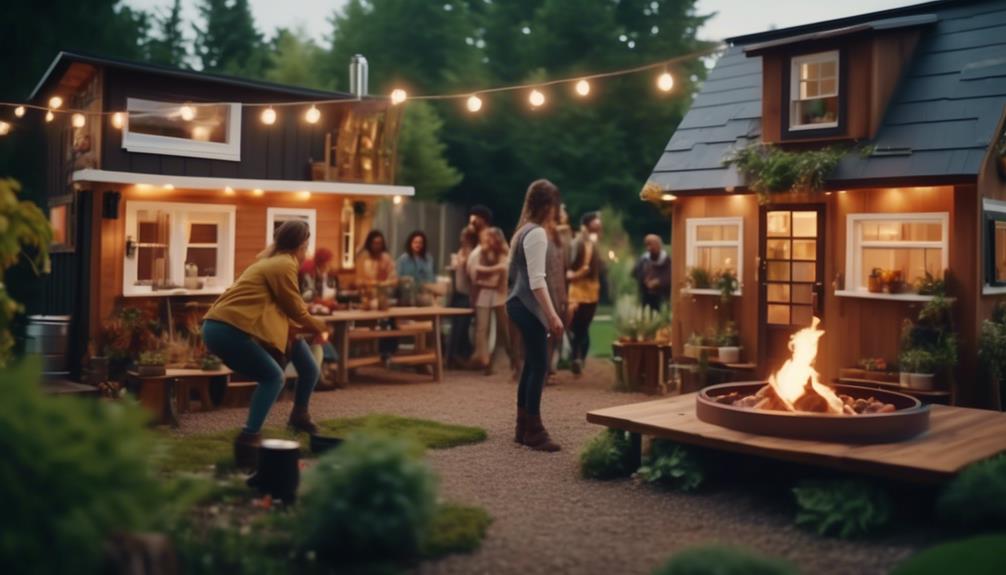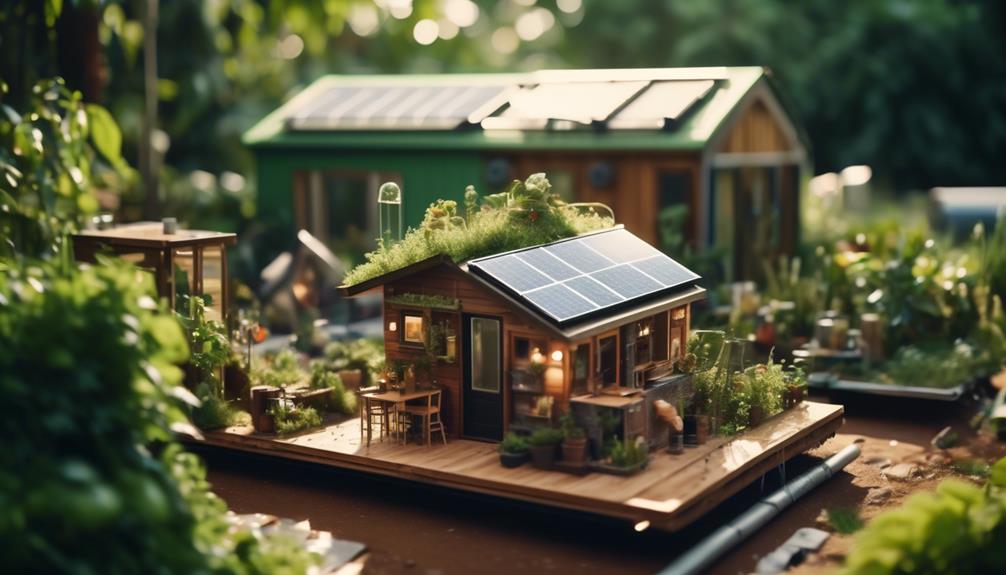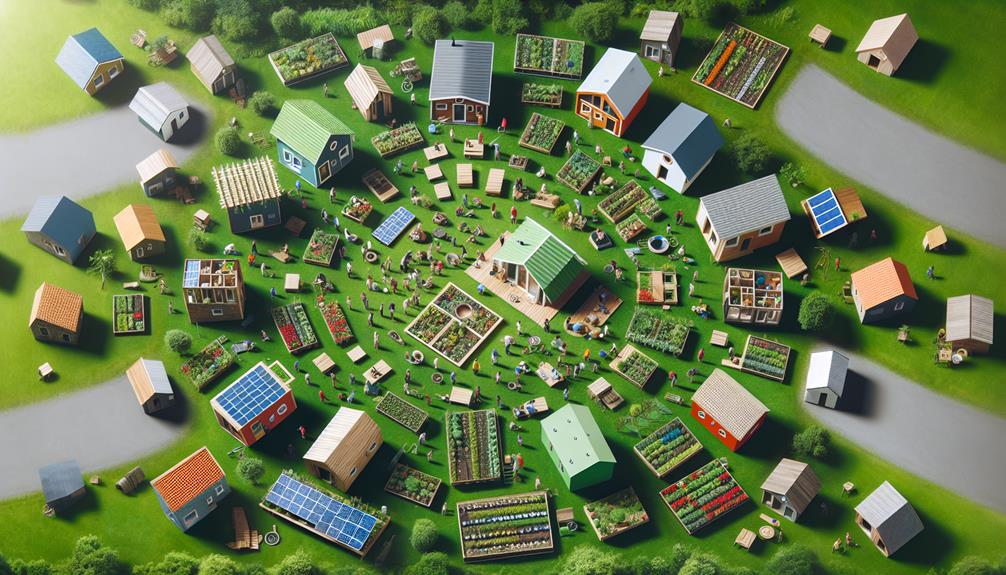You want affordability, sustainability, and a sense of community; creating a tiny home village may be your answer. By joining forces, you're not just building walls and roofs, but you're also constructing a shared vision of minimalistic living where every square foot is packed with purpose.
As you consider the path to downsizing your life and upsizing your connections, remember that the journey is laced with legal intricacies, financial hurdles, and design challenges that require a blend of creativity and practicality.
Navigating the complexities of zoning laws and building codes, you'll find that the blueprint of a tiny home community extends far beyond its physical layout.
Stay tuned to uncover how collective effort and careful planning could pave the way to your quaint, eco-friendly haven.
Key Takeaways
- Thoroughly understand zoning codes and engage with local officials to navigate zoning challenges
- Strategically integrate shared living spaces and design communal gardens and multi-use recreational areas
- Develop a strategic financing plan that balances fiscal responsibility with an eco-conscious ethos
- Implement sustainable practices such as using energy-efficient appliances, recycled building materials, and renewable energy sources like solar panels
Embracing Community Ideals
To build a cohesive tiny home community, you'll need to strategically integrate shared living spaces that not only enhance a sense of belonging but also promote eco-friendly living through the judicious use of communal resources.
Prioritize community building by designing shared gardens and multi-use recreational areas that encourage interaction and mutual support. These shared spaces become the heart of community events, fostering a robust sense of community.
Incorporate shared resources like communal kitchens and entertainment spaces to cut living costs and stimulate social engagement. Tackling zoning challenges and collaborating with local officials will be critical in establishing a strong community foundation.
Addressing volunteer burnout and financial constraints head-on ensures the sustainability of your collective vision. Remember, building a strong, interconnected community is as vital as the eco-conscious homes you construct.
Navigating Zoning Challenges
Navigating the complex terrain of local zoning laws is a pivotal step in the development of a sustainable tiny home community. As you delve into this venture, it's essential to thoroughly understand zoning codes and land-use regulations.
Engage with local officials and planners proactively; their insights can guide you in proposing viable zoning changes that align with the tiny house movement's ethos.
Addressing NIMBY-ism and financial constraints requires a strategic approach, highlighting the eco-conscious benefits of your planning. Research and strict compliance with legal aspects will lay a solid foundation for your real estate project.
Moreover, connecting with utility providers early on can clarify restrictions and requirements, ensuring that your tiny home community not only inspires innovation but stands as a legally sound blueprint for future development.
Designing Shared Spaces

Having addressed the intricacies of zoning laws, your focus must now shift towards the strategic creation of shared spaces that serve as the backbone of community interaction and sustainable living in your tiny home development.
In crafting these communal living areas, it's vital to integrate multi-purpose structures that not only optimize land use but also resonate with shared values. Consider incorporating community gardens, which not only greenify outdoor spaces but also promote resource sharing—from gardening tools to potluck dinners.
Envision a central hub where community members converge, reinforcing connectivity and collaboration. An eco-conscious approach to designing shared spaces might entail a communal kitchen that doubles as an entertainment area or even a hot tub that serves as a relaxing meeting point.
Every square foot should reflect a commitment to innovative, cohesive living.
Financing the Village Dream
Transforming the vision of a sustainable tiny home community into a tangible reality demands a strategic approach to financing, one that balances fiscal responsibility with the collective eco-conscious ethos.
Your business plan must articulate how financing the village dream serves as an affordable housing solution while adhering to building codes and mitigating environmental impact.
It's crucial to evaluate whether purchasing a piece of property outright or securing a loan aligns with the community's sustainable living goals.
Engage with local officials to navigate zoning challenges, ensuring the plan to build is legally sound and community provides value to all stakeholders.
Building Sustainable Practices

Once you've secured funding for your tiny home community, it's vital to focus on building sustainable practices that ensure both environmental integrity and a robust, shared lifestyle. As an innovative thinker, you recognize the urgency to reduce the ecological footprint of your living spaces.
Strategically, you can:
- Integrate energy-efficient appliances and recycled building materials to diminish reliance on traditional, resource-heavy options.
- Install solar panels to harness renewable energy, slashing utility costs and promoting environmental health.
- Implement systems to minimize waste, including comprehensive recycling and composting programs.
Frequently Asked Questions
How to Build a Community in a Tiny House?
To build a community, you'll tackle zoning challenges, design shared amenities, and create common spaces with a sustainable ethos. You'll navigate legal considerations, foster healthy social dynamics, and be strategic in resident selection.
How Do You Connect Multiple Tiny Homes Together?
Weaving a tapestry of tiny homes, you'll intertwine them with modular design and shared amenities. Ensure zoning regulations allow it, and plan for common utilities and connectivity options that respect architectural cohesion and sustainable practices.
How Many Tiny Houses Can You Fit on 1 Acre of Land if Building a Small Community?
You'll fit 6-10 tiny houses on an acre, balancing zoning regulations, land utilization, and privacy considerations. Factor in common amenities, community layout, infrastructure planning, sustainability practices, ownership models, design variations, and legal compliance for success.
Is Building Tiny Homes Profitable?
You'll find that building tiny homes can be profitable. Solid financial planning, efficient design, and sustainable materials boost profit margins. Investment returns hinge on market demand, rental opportunities, and navigating zoning challenges with a strategic cost analysis.
Conclusion
In crafting your tiny home community, remember that 68% of tiny house owners are mortgage-free, compared to just 29.3% of traditional homeowners. This isn't just a statistic; it's a strategic move towards financial liberation and eco-conscious living.
By overcoming regulatory hurdles and designing communal spaces, you'll not only reduce expenses but also foster a sustainable, close-knit environment.
Build not just homes, but a shared vision for a greener, more connected future.

